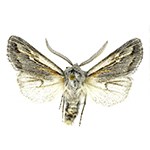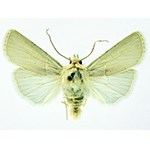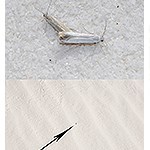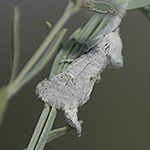
NPS Photo
It is important to study moths because they are critically important in the environment. Moths account for eight percent of all living eukaryotes (higher life forms) both in terms of number of species and in terms of number of individuals. Insects are the dominant life form on earth at more than 50% of all plant and animals. Moths are the second largest group of insects, only surpassed by beetles. The importance of moths cannot be overstated simply because of their large numbers, they are critically important as nutrition for other animals. Without caterpillars the number of songbirds would all but disappear along with all the other plants and animals in the food web and ecology. Some moth species can be serious pests in the agriculture industry, thus there is a need to be constantly monitoring for pest species. Moths play an important role in pollination, in some cases they are the only pollinators. Many of the flowers that are visited by bees and other insects during the daytime are also visited by moths during the night-time hours when much pollination takes place. All moths start life as caterpillars, even though caterpillars eat leaves, in a strange twist of events when a caterpillar takes a bite out of a leaf, the plant releases chemicals, called pheromones, that attract parasites to destroy the caterpillars. When one plant puts out the pheromones, other nearby plants are caused to put out pheromones which draw in even more parasites. Ninety nine percent of moth caterpillars are vegetarians. They eat fresh leaves and some species eat decaying leaves. Much of the initial breakdown of plant material into fertile soil is done by caterpillars, which then become moths. The moths at White Sands National Park present a unique opportunity to learn more about moths and how they evolve and adapt to harsh and unique environments. White Sands is home to more endemic (an endemic species lives no other place on earth) species of moths than any other single location in North America. Because the gypsum dunefield formation is young in geologic terms, it provides an undisturbed natural laboratory for the opportunity to study moths and their interactions with other organisms in a closed island ecology (the gypsum dunes are an island of gypsum in the southwestern United States). The current research on the park's moths began in 2007, and since that time, more than 60 new species of moths have been discovered in the park. The amount of information gleaned is enormous. The study of moths is just scratching the surface of the opportunities for more scientific research, that will follow because of the unique moths located here. Below are just four examples of moths discovered at the park. 
E. Metlzer 
E. Metzler 
E. Metzler The name of the moth is directly related to White Sands National National Park. Arena is Latin for sand and scythris refers to the moth family, Scythrididae. Areniscythris refers to a sand loving Scythrididae. The species name whitesands refers to the National Park. The name of this moth means the sand loving Scythrididae from White Sands National National Park. 
E. Metzler |
Last updated: July 13, 2023
